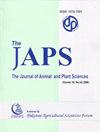贝宁东北部红马拉迪奶山羊农场的类型学
IF 0.5
4区 生物学
Q3 AGRICULTURE, MULTIDISCIPLINARY
引用次数: 0
摘要
牲畜系统的特征能够识别牲畜养殖场的多样性,从而确定发展行动。本研究的目的是描述在贝宁东北部红马拉迪山羊农场观察到的不同耕作方式。数据收集于2019年8月至12月期间在90个山羊农场进行,这些农场至少有一个红马拉迪山羊品种的繁殖核心。采用多对应因子分析(AFCM)和上升层次分类(CAH)方法,建立了该地区红马拉迪山羊养殖场的类型学。因此,确定了红马拉迪山羊的四种繁殖类型。农牧民、商人(27.59%)和工匠(17.24%)主要来自巴里巴社会文化族群(38.72%),是流浪农民农场(第1型)的特征。他们负责购买数量不多(15±8头)的畜群。93.1%的养殖场采用流浪山羊饲养方式,6.9%的养殖场采用半流浪山羊饲养方式。这些动物几乎没有羊圈。农场(类型2)为半食腐农民畜群,主要以富拉尼和甘多社会文化族群的育种者和农业育种者为特征(56%)。他们负责小牛群(16±8头)和山羊的季节性流浪(88%)。这些农场(58.07%)的牲畜被安置在一个基本的羊圈中,并接受作物残留物作为补充。3型,半改良农民育种的育种者来自一个非常多样化的社会文化族群,Dendi (23%), Yorouba (19%), Fon (11.5%), Bariba(12.5%),教育水平相对较高。75%以上的类型育种者达到了二级水平。他们将自己的主要活动、公共服务、商业和手工艺结合起来,饲养山羊,羊群规模相对较大(20±15头)。这些动物被安置在更改良的羊圈里,羊圈建在粗糙或坚硬的土地上,75%的农场在羊圈里获得食物和水。第4类,红马拉迪山羊的半集约化奶牛养殖,将生产和升级羊奶的农场聚集在一起。Fon(51.25%)和Bariba(48.75%)主要拥有这些农场。他们负责较大的牧群(57±7头),因此35%由红色马拉迪山羊和其余的萨宁品种组成。这些动物有一个永久的羊圈,除了由饲料组成的基本口粮外,还有由浓缩物组成的生产补给品。本文章由计算机程序翻译,如有差异,请以英文原文为准。
Typology of red maradi dairy goat farms in the north east of Benin
1 ABSTRACT The characterization of livestock systems enables to identify the diversity of livestock farms in order to define development actions. The aim of this study is to characterize the different farming practices observed in the Red Maradi goat farms located in the North East of Benin. Data collection took place between August and December 2019, in 90 goat farms with at least one breeding nucleus of the Red Maradi breed. Using the Multiple Correspondence Factor Analysis (AFCM) and Ascending Hierarchical Classification (CAH) methods, a typology of Red Maradi goat farms in the region was developed. Thus, four types of breeding of Red Maradi goats were identified. Agro-pastoralists, traders (27.59%) and craftsmen (17.24%) mostly from the Bariba socio-cultural ethnic group (38.72%) characterize wandering peasant farms (type 1). They are responsible for herds of modest numbers (15 ± 8 heads) made up by purchase. The mode of rearing goat straying is practiced in 93.1% of these farms against 6.9% of semi-straying. The animals hardly have a sheepfold. The farms (type 2), semi-scavenging peasant herds, are mainly characterized by breeders and agro-breeders of the Fulani and Gando socio-cultural ethnic group (56%). They are responsible for small herds (16 ± 8 heads) and practice the seasonal straying of goats (88%). The animals are housed on these farms (58.07%) in a basic sheepfold and receive crop residues as a supplement. The breeders of type 3, semi-improved peasant breeding are from a very diverse socio-cultural ethnic group Dendi (23%), Yorouba (19%), Fon (11.5%), Bariba (12.5%) with a relatively higher level of education. Over 75% of type breeders have reached secondary level. They combine their main activity, public service, commerce and crafts, the breeding of goats with herds of relatively larger size (20 ± 15 heads). The animals are housed in more improved sheepfolds built in roughcast or hard earth and in 75% of these farms receive food and water in the pen. Type 4, semi-intensive dairy farming of Red Maradi goats, brings together farm farms producing and upgrading goat's milk. Fon (51.25%) and Bariba (48.75%) mostly own these farms. They are responsible for larger herds (57 ± 7 heads) so 35% is made up of the Red Maradi goat and the rest of the Saanen breed. The animals have a permanent sheepfold and, in addition to the basic ration consisting of fodder, a production supplement consisting of concentrate.
求助全文
通过发布文献求助,成功后即可免费获取论文全文。
去求助
来源期刊

Journal of Animal and Plant Sciences
Multiple-
CiteScore
1.50
自引率
0.00%
发文量
128
审稿时长
6 months
期刊介绍:
The Journal of Animal and Plant Sciences (JAPS) is a bi-monthly publication and is being published regularly since 1991 by the Pakistan Agricultural Scientists Forum (PAS FORUM). It publishes original research papers, review, extension/clinical articles on all aspects of animal (including fisheries/wildlife) and plant sciences, agricultural economics, rural sociology and other related subjects. The journal is read, abstracted and indexed by the abstracting/indexing agencies of international repute.
 求助内容:
求助内容: 应助结果提醒方式:
应助结果提醒方式:


